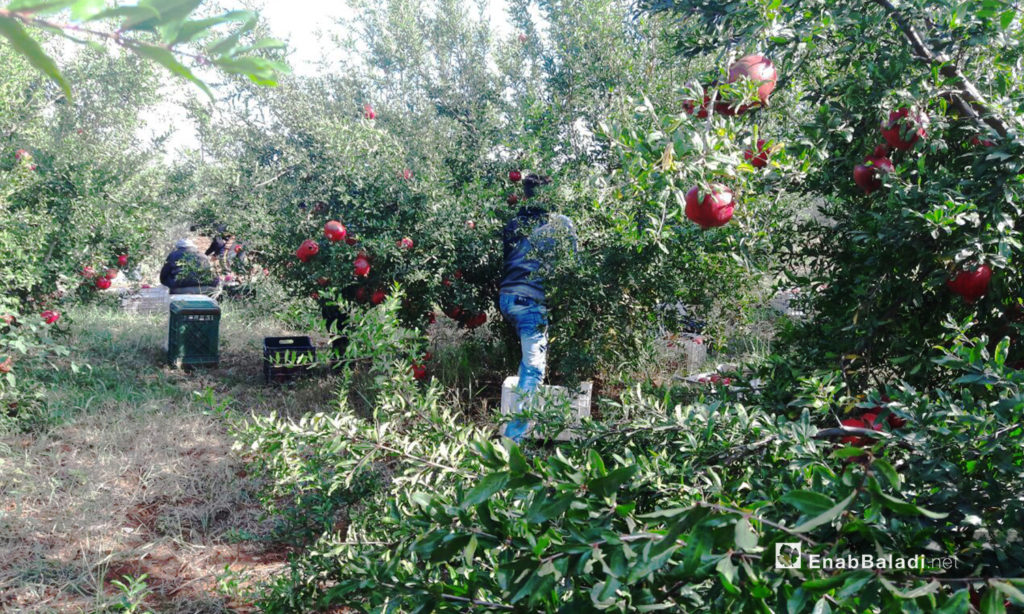Daraa – Halim Muhammad
Early in the morning, Youssef starts pruning pomegranate trees, an activity that requires skill and expertise that a few have.
The young farmer, who has several years’ experience in pruning the overgrown pomegranate bushes, is in high demand by pomegranate orchard owners, who came to recruit him in person to ensure a good season. Wearing a knitted wool hat and thick gloves, Youssef uses a pair of sharp pruning shears to remove the dead or damaged branches of pomegranate trees properly.
The pomegranate cultivation has expanded over the past decade and turned into “a strategic crop” covering the domestic market supply and is also exported to Jordan and the Arab Gulf states. Thus, the cultivation of pomegranate trees and bushes has created new job opportunities in the pruning of pomegranate trees, an activity that few have expertise in.
Pruning pomegranate trees require lots of expertise
With the end of the harvest season, the process of pruning the trees starts. Youssef begins by cutting off any new water shoots or “suckers.” Then, he starts to trim the high branches that are in the shade and will bear no fruit. “ The branches should be away from the ground at a distance between 70 and 100 cm,” Youssef highlighted to Enab Baladi.
Thus, the tree takes a beautiful shape gradually. “Pruning is also necessary for the tree’s health and safety,” according to Youssef. Pruning increases flowering and fruiting; it distributes the fruit load in all directions of the tree and removes the extra branches so that the load does not go in one direction.
Some landowners ask to distribute the tree’s fruit crop on one trunk, while others on two or three trunks, Youssef added while cutting down old trunks with a saw.
Taking into account the size and age of the tree is essential when distributing the fruit crop load. “The small trees with fresh fruits do not carry large quantities so that their trunks do not break,” said Ayman, a 30-year-old farmer who has been working in this profession for years.
Abu Mahmoud, the sixty-year-old farmer who owns a farm of 20 dunums, is looking for a highly qualified arborist. He tells Enab Baladi that pruning is the first essential step in ensuring a bumper harvest of pomegranates. The tree surgeon’s role and experience play a role in distributing the trees’ load each season. That’s why he thinks that it is necessary to hire a skilled arborist for his trees.
Tree care professionals’ wages are three times higher
This year tree care arborists’ wages have increased more than three times compared to last season. A tree care professional was paid a small salary in 2019- only five thousand Syrian Pounds (SYP-1.6 USD). But this year, a tree care arborist’s salary amounts to 18 thousand SYP (6.6 USD), which raised fear among farmers.
“The season started this year with a rise in tree care professionals’ wages. We still have to pay for organic fertilizers, medicines, plowing the land, and other things,” said farmer Muhammad Saeed (24 years old) to Enab Baladi.
Youssef justified the increase in wages by the high cost of living and the high prices of everything following the deterioration of the purchasing power of the SYP against the US dollar; the SYP recorded an exchange rate of 2,755 against the US dollar, according to the website of Syrian Pound Today (a Syrian Pound tracking website).
According to Youssef, the increase in wages is also related to technical expertise, who added that pruning trees is “arduous,” especially when pruning large trees that always leave “scratches” on the worker’s body despite wearing thick clothes.
The tree care arborist’s productivity per day ranges between a dunum (about 920 square acres) and a dunum and a half of land. The size depends on the age of the trees, their density, and the quality of pomegranate trees’ pruning that took place in the previous year, according to Youssef.
After the pruning is over, the tree care arborist uses the branches and trunks he saws as firewood for warmth.
The cultivation of pomegranate has expanded in the southern governorate at the expense of cultivating grapevines and olives in recent years. The most popular and sought-after type is the French pomegranate, which can be stored and exported.
The Daraa Agriculture Directorate estimated the governorate’s production of pomegranates for the current year at 35,000 tons, while the number of pomegranate trees in Daraa before 2012 reached 500,000 tons.

